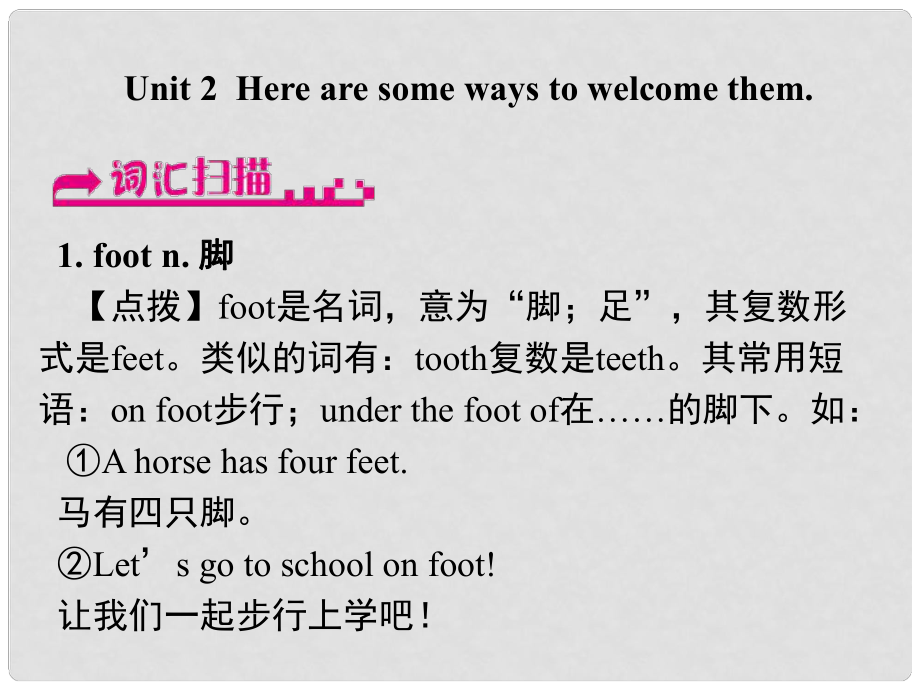《浙江省嘉興市秀洲區(qū)七年級英語下冊 Module 11 Body language Unit 2 Here are some ways to welcome them課件 (新版)外研版》由會員分享���,可在線閱讀��,更多相關(guān)《浙江省嘉興市秀洲區(qū)七年級英語下冊 Module 11 Body language Unit 2 Here are some ways to welcome them課件 (新版)外研版(15頁珍藏版)》請在裝配圖網(wǎng)上搜索��。
1���、Unit 2 Here are some ways to welcome them. 1. foot n. 腳腳【點撥】foot是名詞,意為“腳��;足”,其復(fù)數(shù)形式是feet��。類似的詞有:tooth復(fù)數(shù)是teeth��。其常用短語:on foot步行��;under the foot of在的腳下���。如: A horse has four feet. 馬有四只腳��。 Lets go to school on foot! 讓我們一起步行上學(xué)吧���! 2. move vt. & vi. 搬(家);移動搬(家)���;移動【點撥】(1)move作及物動詞時��,其后可以直接跟名詞��。如: The little boy is mo
2��、ving the box. 那個小男孩正在搬箱子���。(2)move作不及物動詞時��,常用短語:move(from.) to+地點名詞���,意為“(從)搬到地方”。如: Two years ago we moved to Beijing. 兩年前我們搬到了北京���。 Theyre going to move from Shanghai to London. 他們將要從上海搬往倫敦��。 【延伸】(1)move v. (使)感動��;moving adj. 動人的;moved adj. 感動的���。如: I was moved by the story. 我被這個故事感動了��。(2)move的相關(guān)短語:move about
3���、到處活動,動來動去��;move on(使)繼續(xù)前進��,不停地向前走���,向前���;move away搬走��,離開���。 3. personal adj. 個人的個人的 【點撥】personal是形容詞,相當(dāng)于private��。其名詞形式為person(人)���,為可數(shù)名詞��。如: Give them more personal space. 多給他們點個人空間��。 Dont touch his personal things. 不要動他的私人物品���。 4. arm in arm 臂挽臂地臂挽臂地 【點撥】arm in arm意為“臂挽臂地”。如: Chinese girls often walk arm in arm wi
4��、th their friends. 中國女孩經(jīng)常與她們的朋友臂挽臂地走路���。 【延伸】與身體部位有關(guān)的短語:an eye for an eye, a tooth for a tooth以眼還眼��,以牙還牙���;see eye to eye同意某人的觀點���;head to head交頭接耳;face to face面對面���;nose to nose面對面���;ear to ear咧著嘴;back to back背對背���;shoulder to shoulder肩并肩;heart to heart心連心���;neck and neck齊頭并進���;hand in hand手拉手;foot by foot一步一步地���。 5.
5���、in fact 事實上事實上 【點撥】in fact是固定搭配��,意為“其實��;事實上”��,和actually是同義表達���。如: In fact, its very rude! 事實上,這非常無禮���! 【延伸】與in相關(guān)的短語還有:in time及時��;in all總的來說���;in total總共;in the future在未來��;in a word總之���;in the end最后���;終于���;in a hurry趕快;in trouble處于困境中���;in danger在危險中���。 1. You can stand close to people in the Middle East but dont stand t
6、oo close to North Americans! 在中東���,你可以站得離人們近些���,但是不要站得在中東,你可以站得離人們近些��,但是不要站得離北美人太近��!離北美人太近��! 句中close是副詞��,意為“近地��;接近地”���,常構(gòu)成短語close to��,意為“靠近��;很近地”��。 【延伸】close也可作形容詞和動詞���。作動詞時,意為“關(guān)閉”���。如:close ones eyes閉上眼睛���;close the door關(guān)門。其反義詞為open���,意為“打開”���。作 形容詞時,意為“近的��;接近的”。如: My home is close to the school. 我的家靠近學(xué)校��。 2. How about touc
7���、hing people? 觸碰他人怎么樣呢���?觸碰他人怎么樣呢? 【點撥】What/How about.?意為“怎么樣”���,用來征求別人的意見���、詢問天氣(身體)等情況或提出建議。其具體用法如下:(1)what/how about后可接名詞或代詞���,接代詞時要用賓格形式��。如: We went to the park yesterday. What about them? 我們昨天去公園了���,他們呢? (2)what/how about后接動詞時��,要用動詞-ing形式���。如: How/What about going shopping at the week-end? 周末去購物怎么樣���? 3. It isn
8、t polite to look somewhere else. 看著其他地方是不禮貌的��?�?粗渌胤绞遣欢Y貌的��。 【點撥】此句型結(jié)構(gòu)為:It is+adj.(+of/for sb.)+to do sth.意為“做某事對某人來說是的”���。其中��,it是形式主語��,“to do sth.”是真正的主語���。當(dāng)adj. 修飾事時,介詞用for��。如: Its difficult for us to finish the work. 對我們來說���,完成這項工作很困難��。(形容詞“difficult”修飾事“to finish the work”���。) 當(dāng)adj. 修飾人時���,介詞用of。如: Its very kind
9��、 of you to help me. 你幫助我真是太好了��。(形容詞“kind”修飾人“you”���。) 4. In Greece, its not at all polite! 在希臘��,那絕對是不禮貌的��!在希臘��,那絕對是不禮貌的���! 【點撥】句中not at all一般可以修飾形容詞,表示與形容詞相反的意思��,意為“絕對不是”。如:You are not at all right. 你絕對錯了���。not.at all中間填形容詞或副詞��,表示“一點也不”。如: Im not busy at all. 我一點都不忙���。 【延伸】Not at all.是英語口語中一個常用的表達形式���,其主要用法歸納如下:(1)
10、用于回答感謝��,意為“不用謝��;不客氣”���。如: Thank you very much. 多謝你了���。 Not at all. 不客氣。(2)用于回答帶有感謝性質(zhì)的客套話���,意為“沒什么��;哪里哪里”���。如:Its very kind of you. 你真好��。Not at all. 哪里哪里��。(3)用于回答道歉���,意為“沒關(guān)系”。如: Im sorry Im late. 對不起���,我遲到了��。 Oh, not at all, do come in. 噢���,沒關(guān)系,請進來��。(4)用來表示否定(是No.的加強說法)��,意為“一點也不��;完全不”���。如: Are you busy? 你忙嗎���?Not at all. 一點都不忙���。
 浙江省嘉興市秀洲區(qū)七年級英語下冊 Module 11 Body language Unit 2 Here are some ways to welcome them課件 (新版)外研版
浙江省嘉興市秀洲區(qū)七年級英語下冊 Module 11 Body language Unit 2 Here are some ways to welcome them課件 (新版)外研版

